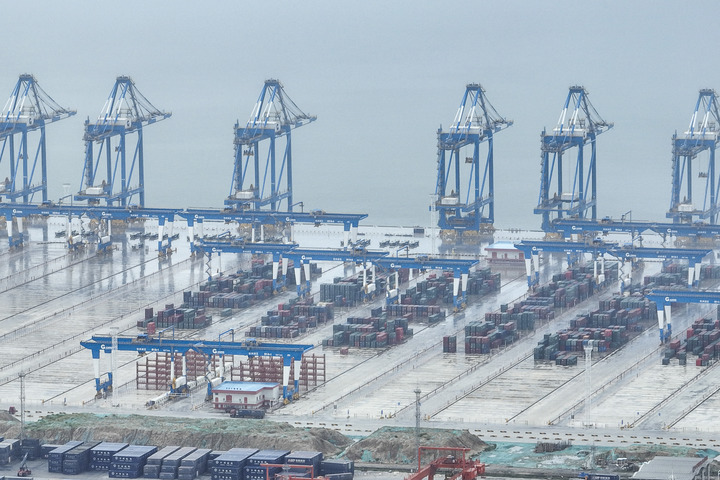China maps out four-pronged measures to enhance new int'l land-sea trade corridor

This aerial photo taken on July 22, 2023 shows an automated container wharf of the Beibu Gulf Port in Qinzhou, south China's Guangxi Zhuang Autonomous Region. Qinzhou is a node of the New International Land-Sea Trade Corridor connecting Guangxi and ASEAN countries, and its location is highly beneficial, granting the city an important role in international land-sea transport connectivity. (Xinhua/Cao Yiming)
Chinese customs regulator released recently a basket of four-pronged measures to bolster logistics, opening-up, industries and business environment to better leverage development of the New International Land-Sea Trade Corridor in west China.
As a trade and logistics passage jointly built by western China provincial-level regions and ASEAN countries, the land-sea trade corridor, also one of the key projects under the Belt and Road Initiative, means much to advance the high-level opening-up of west China.
-- "Four betters" outlined to better build the land-sea trade corridor
In general, the 15 measures released by General Administration of Customs (GAC), the Chinese customs regulator can be summarized as "four betters", said Wu Haiping, director of the comprehensive business department of GAC at a news briefing held recently.
The first one is to better facilitate cross-border logistics flow through the corridor, which, prioritized as a key task, includes improving customs clearance for related multimodal transportation so as to foster capacity expansion of international railway joint transport, crafting a logistics interaction platform, and promoting connection between the corridor and China-Europe freight trains and Yangtze River golden waterway as well to thoroughly display its role in linking with the Belt and Road and the Yangtze River economic belt.
The second one is to better shape west China into an inland opening-up highland via the corridor. A slew of measures were proposed, such as supporting application for establishment of comprehensive bonded zones and bonded logistics centers, cranking up efforts to boost western China opening-up platforms, advancing coordination among free trade zones (FTZs) alongside the corridor, promoting replication and application of innovative FTZ customs supervision rules, and working on interaction between the western China opening-up platforms and the corridor.
The third is to better serve the economic, trade and industrial development alongside the corridor in a bid to turn its advantages as a grand logistics channel and an opening-up portal into its advantageous economic, trade and industrial development.
Efforts will be taken to step up implementation of the regional comprehensive economic partnership (RCEP) in the corridor, help and guide key industries and enterprises to fully enjoy the benefits brought by the RCEP, and facilitate industrial cooperation with ASEAN members.
The fourth is to better optimize the business environment of the corridor, mainly by strengthening inspection and quarantine cooperation with customs of ASEAN nations and reinforcing coordination among local customs alongside the corridor in west China.
-- Resolving the dilemma of west China goods exporting through eastern coastal regions
As a vibrant driver for cross-region resources flow, the bustling corridor helps significantly lower related logistics time and costs and solves in an effective manner the dilemma of long-lasting exporting of goods from west China through coastal regions in east China.
Public data showed that railway-sea joint transport cargo train trips through the New International Land-Sea Trade Corridor rose nine percent year on year to 4,510 ones in the first half of this year.
Wu said that the increasingly diversified logistics modes and booming logistic flows of the corridor posed higher requirements for strict customs supervision and highly efficient services, and the 15 measures proposed new ways to facilitate faster customs clearance, transport of more types of products and connection with broader regions of the corridor.
For instance, enclosed auto trains and cold chain trains are encouraged to operate among China-Laos freight trains and China-Vietnam freight trains so as to satisfy the transport demand for special goods such as complete vehicles and frozen meat and aquatic products.
Meanwhile, enterprises are supported to run cross-border E-commerce, market purchasing and other business via the China-Laos freight trains and China-Vietnam freight trains to expand the goods sources for the international railway joint transport through the corridor.
-- Broader opening of west China
As a grand channel for national opening-up, the New International Land-Sea Trade Corridor changed west China from a backyard to a forefront for opening-up and unlocked new space to build the area into an opening-up highland.
Statistics showed that from January to June, gross goods exports and imports in west China totaled 1.8 trillion yuan, up 3.5 percent year on year, 1.4 percentage points higher than the comparable national data.
By granting a higher proportion of new bonded zones in west China in recent years, Chinese customs kept its pace on transformation and upgrading of comprehensive bonded zones to boost opening-up development of west China.
Currently, comprehensive bonded zones in west China have increased to 40 ones, accounting for 25 percent of the national total, noted Wu.
In Chongqing, one of the key west China-situated regions for building the corridor, logistics channels heading the north, south, east and west that is capable of handling rail, highway, waterway and air transport are all in shape alongside construction of the corridor.
Seizing chances in implementing the 15 measures, Chongqing customs released detailed supportive measures and appraised timely the policy outcomes to drive forward construction of its international logistics hub linking with the ASEAN market, Eurasia and other parts of the world and further bring up the high-level opening-up of west China, said Wang Honghan, deputy head with the Chongqing Customs District of China.
In the first six months of 2023, Chongqing reported 78,000 Twenty-foot Equivalent Units (TEUs) of goods transport through the corridor, up 36 percent year on year and their aggregate value was 12.28 billion yuan, up 14 percent, signaling a strong growth momentum of logistics flows through the corridor. (Edited by Duan Jing)


